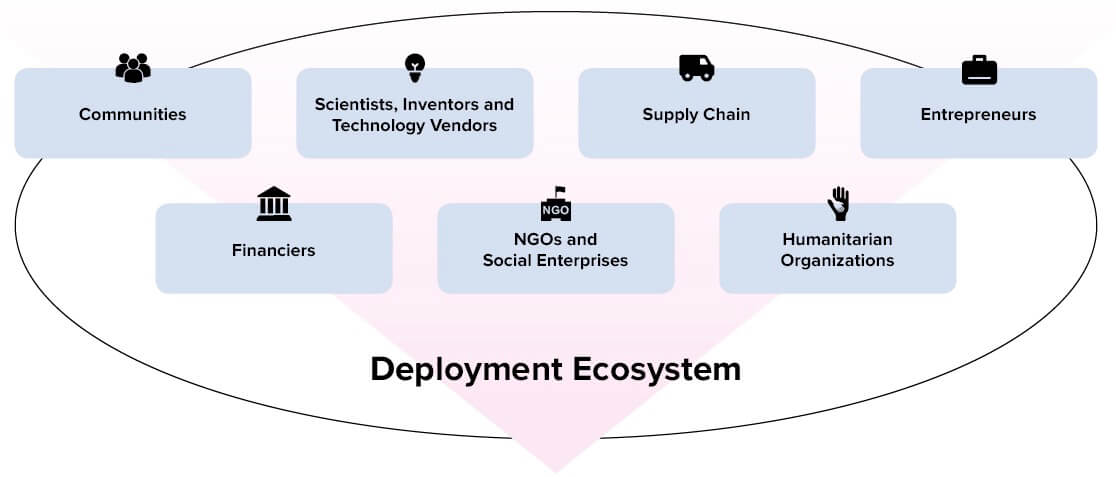How to Deploy Tech Solutions to the World’s Greatest Challenges at Scale

Share
“Build a better mousetrap, and the world will beat a path to your door,” argued Ralph Waldo Emerson, the 19th century US lecturer, philosopher, and essayist. In other words, if scientists and engineers invent a better solution to something, scaling and deployment will happen automatically.
Although Emerson was writing in the 19th century, we are still operating on the basis of his optimistic but misguided premise. Experience suggests that technology deployment is neither simple nor automatic. Inventing a new technology is no guarantee it will be embraced. Steve Jobs knew this and focused as heavily on design and promotion as pure engineering. Modern software engineers release and iterate. Yet in the more challenging context of global development, scientists, researchers, and inventors take it for granted that a promising invention or technology will work as theorized, be accepted automatically in the communities for which it was intended, and spontaneously spread to all who need it.
Because these optimistic assumptions rarely pan out as expected, we can no longer afford technology deployment to be an afterthought as we tackle ambitious development targets like the Global Grand Challenges and UN Sustainable Development Goals.
Deployment is an indispensable piece of the puzzle and requires at least as much attention as the quest for new discoveries and technological solutions. Dr. Akinwumi Adesina, president of the African Development Bank, recently highlighted the deployment problem when he noted that “technologies to achieve Africa’s green revolution exist. For the most part, they are all just sitting on the shelves.” The deployment of these technologies poses a great entrepreneurial challenge. As Dr. Vanu Bose observed 135 years after Emerson, “It takes more creativity and innovation to market a new invention than it did to invent it in the first place."
Alas, green revolution technologies are not the only ones sitting on the shelves, valued in principle but all-too-often unused in practice. There is no shortage of proven, cost-effective, and affordable development solutions for many of the most pressing development challenges. These include off-grid renewable energy, potable water, community health clinics, Wi-Fi access for remote communities, solar powered irrigation pumps, low-cost housing and sanitation, and off-grid food storage, refrigeration, and processing.
“Deployment requires at least as much attention as the quest for new discoveries and technological solutions.”
Although many of these technologies were not developed specifically to address the needs of the more than two billion people at the so-called bottom of the pyramid, they should make it even more affordable and easier, in principle, to hit sustainable, inclusive development targets, especially in the least developed countries where enormous progress is possible simply by deploying proven solutions already in widespread use in other countries.
Why then aren’t we on track to achieve global objectives such as the Sustainable Development Goals? If proven, cost-effective solutions to so many challenges already exist, shouldn’t it be fairly simple and straight-forward to start financing their deployment at scale? The situation is, of course, more complicated than it at first appears. Technology is a powerful first step, but technology alone will not solve the world’s greatest challenges unless we also address the organizational, entrepreneurial, financial, and business development issues associated with getting these solutions into the hands of tens, if not hundreds of millions of people.
Last year, entrepreneurs met at the 2018 Global Solutions Summit to share their collective, hard-won experience deploying technology in emerging markets. Three overarching themes—synthesized here with supporting examples from those in attendance—emerged at the event.
First, new technology will go to rust without an embedded strategy to prepare the soil, so to speak. This preparation includes programs to strengthen the social glue and economic foundations of target communities in parallel with deployment. Second, technology deployment requires a strong entrepreneurial business plan for project sustainability, replicability, scale, and financing from the outset. Starting with a small scale pilot that does not include an explicit plan for scaling will simply not get the job done. And third, due to the increasing complexity of the ecosystem—from inventors to entrepreneurs, financiers, NGOs, foundations, local suppliers, local universities, and governments—technology deployment sorely needs mechanisms to more seamlessly knit together the key players, ideas, and know-how to replicate and scale projects within individual countries and across the globe.
Ideally, insights like these can accelerate the learning curve for the next generation of deployment entrepreneurs and put us on the path to solving the world’s greatest challenges.
Preparing the Soil: The Last Mile Challenge
At first blush, the meaning of the phrase “the last mile” appears self-evident. When it was originally coined, “the last mile” referred to connecting customers to a nearby water, sewage, electric, or telecommunications grid. In developing countries, however, the last mile concept is more complex and often has more to do with socio-economic concepts such as marginalization and exclusion than distance or proximity to a central grid.
In many emerging markets, connecting the local population to a nearby grid or extending the grid to distant communities is expensive and most likely unattainable within the next decade.
Fortunately, newer small-scale distributed solutions—such as rooftop solar, community-based microgrids, neighborhood-based water purification kiosks, and Wi-Fi stations—make grid connections unnecessary, and they are often less expensive too. Here, the phrase “the last mile” refers to deploying decentralized solutions in communities that are currently, and likely to remain, off-grid for the foreseeable future. However, years of on-the-ground experience suggests that successfully deploying these off-grid solutions requires attention to a broad array of sociological factors that are only tangentially related to the technical merits of a piece of technology.
Strengthening Social Glue Makes Tech Solutions Stickier
Jonathan Papoulidis of World Vision urges we go beyond these narrow definitions and focus instead on “the global last mile.” This is not a geographic concept related to proximity to the grid. Nor is it a technology and engineering concept related to centralized versus decentralized solutions. Instead Papoulidis suggests that achieving the last mile is as dependent on the health of communities as it is on technological solutions. Specifically, he is studying the challenge of implementing development solutions in “fragile” contexts.
According to Papoulidis, citing work by the OECD, fragility has five dimensions: political, social, economic, environmental, and security. Fragility exists when a community is exposed to stresses or risks that the political, social, economic, environmental, and/or security arrangements are not agile and resilient enough to cope with, leading to a downward spiral of chaos, despair, and hardship. Contrary to popular belief, security (or more precisely insecurity) is frequently not the predominant source of fragility.[1] Even relatively peaceful communities can be overwhelmed by political, environmental, economic, and social stresses that strain their capacity to cope.
"Successful technology deployment combines smart business models with socioeconomic strategies that build social capital."
How can we achieve our development goals in these fragile contexts? According to Papoulidis, merely deploying water purification filters, drought tolerant seeds, health clinics, off-grid refrigeration and food processing technology, and other small-scale, distributed solutions is not the most effective way to reach the global last mile, since these deployment interventions, by themselves, do little to promote long-term resilience and reduce fragility. Instead, he argues, technology deployment programs need to be embedded in a broader three-pronged anti-fragility, resilience-strengthening strategy[2] consisting of:
Bonding to strengthen social ties within the community, promote self-help approaches, share information and assets, pool funds, and provide psychosocial support.
Bridging to connect different communities that don’t have obvious shared interests. This maximizes joint capabilities in the face of shocks and stress and mends divisions leading to conflict.
Linking communities and local networks with formal institutions and governments.
Although bonding, bridging, and linking may be critically important elements of successful deployment strategies in fragile communities, it turns out that they are often critically important components of successful deployment business models in non-fragile contexts as well.
To cite just a few examples, Heifer International (agriculture), NRECA International (power), and Weconnex (water) are each helping local communities establish local cooperative associations. They refer to their work as building social capital or organizing cooperatives rather than bonding and bridging, but the concepts and underlying approach are broadly synonymous. Similarly, an integral element of the deployment programs developed by NRECA, Weconnex, Feed the Future Partnering for Innovation, Catholic Relief Services, and Mercy Corps entail linking families and communities to formal markets, thereby boosting household incomes and breaking the scourge of informality.
In short, successful technology deployment bridging the last mile combines creative business models (more on this below) with socioeconomic strategies that build social capital via bonding, bridging, and linking. If a technology is the seed, socioeconomic strategies and business models are the soil, water, and sunlight.
Just as there is no one “correct” business model for all sectors and circumstances, there is no one set of tactics for bonding, bridging, and linking. Successful deployment mechanisms generally depend on finding the combination of business model and socioeconomic strategies that meet the unique needs of each community. The choice is not between choosing business models over socioeconomic strategies, or vice versa, but rather on deploying both strategies simultaneously to reinforce each other.
Tech Is Ever More Affordable—But Sometimes That’s Still Not Enough
In addition to strengthening social ties, helping communities build a solid economic foundation can link increasingly affordable technologies with those for whom these technologies are still just out of reach.
In many cases, last mile consumers and communities do not have access to potable water or off-grid power because they cannot afford it. Low-cost, distributed technology and innovative business models can make services less expensive, but these initiatives are often still insufficient to bridge the gap between a family or community’s current income and the amount needed to afford basic services. A second option, therefore, is to couple technology deployment initiatives with explicit programs to generate more income for households and communities by enhancing access to formal markets. These income-generating, market access programs are not distractions or minor add-ons to existing deployment programs—they are often pre-requisites for success.
As Shaun Ferris of Catholic Relief Services observed at the Summit, “Technology deployment is not merely about asset delivery....It’s about creating opportunity for smallholders to talk with their dollars.”
Weconnex, for example, set out initially to provide potable water and off-grid electric services to poor communities in Madagascar and Nepal. But via a process of trial and error, along with a string of initial setbacks, they concluded that their deployment efforts would never succeed unless they found a way to boost the income of the communities and households where they were working. So they helped these communities organize farming and fishing marketing cooperatives and establish stronger links between the coops and formal markets so their fish and produce would fetch much higher prices.
Along the way, Weconnex transformed itself from a technology vendor into a farm produce and fish marketing company that also happens to sell technology for water purification and off-grid power generation.
Similarly, Heifer International is helping smallholder farmers in developing countries build social capital, organize agricultural coops to market crops, and purchase inputs. At the same time, they’re working to increase access to electricity, potable water, and a host of other development services.[3] As Hilary Haddigan of Heifer explained, the success of those coop programs rests on a simple proposition: “Technology deployment is not about technology; it’s about people.” More specifically, it is about helping communities generate social capital—what Papoulidis’s bonding, bridging, and linking aim to achieve—for market-led development.
By banding together, these Heifer coops form “one stop shops” linking farmers to formal markets, processors, financiers, and input suppliers. They also generate impressive increases in income—from $1.09 per day to $4.60 per day between 2009 and 2015 in the case of Malawi. Similarly, Heifer’s East Africa Dairy Development Program, financed by a grant from the Gates Foundation, helped 179,000 East African dairy farmers boost annual milk sales by $131 million. With this additional income, farmers can afford to purchase potable water, power, education, health care, and other essential services.
The Entrepreneurial Spirit: Aim High, Get Modular, Go Viral
The entrepreneurial side of the coin—including scalable business plans and financing—is just as important as socioeconomic strategies. It’s not an either-or proposition: An innovative new piece of technology can simultaneously take root and take flight only if the right socioeconomic and entrepreneurial strategies are in place. The latter, especially, require a great deal of creativity because the most successful development projects need to be both locally tailored and also adaptable enough to spread to communities across the globe.
Luckily, much work has been (and continues to be) done to realize this goal.
Plan to Scale Impact to Millions or Billions From Day One
One thing we can say without fear of contradiction is that scaling is difficult.
Speaking during his presidency about education reforms former President Bill Clinton noted, “Nearly every problem has been solved by someone, somewhere. The frustration is that we can’t seem to replicate [those solutions] anywhere else.” Or as Chris Walker of Mercy Corps and his colleagues at the Innovation Investment Alliance and Duke University asked, “When there are hundreds, if not thousands, of new mission-driven enterprises emerging around the world, why are there so few examples of social enterprises that scale to achieve systems change?”
At first blush, scaling shouldn’t be so challenging.
If an NGO is providing potable drinking water or roof-top solar panels to 10 households in a village, it should not be too difficult to provide the same services to 100 households in the same village. But what if the goal is to scale up from 100 households in one village to 500 households in each of 10,000 communities? Reaching five million households is an exponentially larger and inherently more daunting exercise. Further, reaching five million households a year is a drop in the bucket—woefully inadequate compared to the two billion people who currently do not have reliable access to safe water or the four billion who will lack access by 2030 based on current population trends. At current rates of deployment, we are not even close to achieving this objective. The same holds true in other key areas, such as energy.
So what will it take to mount a successful scaling effort, one that is commensurate with the challenge of achieving our biggest, most audacious development goals? For starters, factor scale in from the beginning.
"Start with a global vision and plan backward from there."
Scaling should not be treated as an afterthought or an add-on to a small pilot project. It must be a primary objective and integral component of the deployment program from day one. All too often, we start by funding a small-scale pilot project in one village and, if it is successful, raising money to expand it to several more villages. This small-scale, piecemeal approach will never achieve broad development goals because entrepreneurs with good ideas are all too often unprepared to escape the so-called “stagnation chasm.”
Instead, as Jonathan Papoulidis explained, we need to start with a global vision—provide drinking water to at least 100,000,000 people in the next 5 years—and plan backward from there to determine what will be required to achieve that objective, develop strategies for mobilizing essential resources (i.e., technical, financial, social, political), and figure out how to start implementing that strategy.
You Don’t Have to Do It All: Achieving Scale by Enabling Others
A variety of mechanisms for scaling in one country were featured at the Summit, some of which are already reaching tens of thousands of people. These programs are laudable. But many social enterprises that have scaled in one country simply do not have the financial and managerial capacity to expand their operations even to neighboring countries, not to mention more distant locales and continents. Scaling globally requires, at a minimum, mechanisms to transfer know-how and experience from country to country.
"If [successful social enterprises] really want to go to scale, they have to become active facilitators of their own replication.” –Kevin Star and Greg Coussa
In addition to planning for scale, then, projects should be designed for replicability. Instead of directly leading every new implementation, originators should package and widely share their framework to empower others to replicate it, no matter where they are and in whatever way best fits local conditions.
In the words of Kevin Star and Greg Coussa (who did not speak at the Summit), “If [successful social enterprises] really want to go to scale, they have to become active facilitators of their own replication. They have to shift from working exclusively as direct doer to taking on at least a partial role as teacher and supporter. They need to package up their model as a systematic, doable intervention (including the systems that make it doable) and ‘sell’ it to those most able to replicate it at scale. They then have to support—often intensively—the successful implementation of the model.”
Fortunately, many organizations are beginning to follow this advice.
Jibu, for example, is developing master franchise agreements to facilitate country-to-country knowledge transfer of their franchise approach to the provision of potable water. In infrastructure and lending, Weconnex and Shared Interest are sharing their business models with NGOs wanting to implement them in countries where the two organizations are not currently operating. Safe Water Network is developing tools, training materials, and capacity-building programs so other organizations can adopt their model.[4]
Funding Projects With a Better Financial Plumbing System
All is for naught without the funding to make it happen (and keep it happening).
At a July 2015 meeting in Addis Ababa, Ethiopia, the UN encouraged “long-term institutional investors, such as pension funds and sovereign wealth funds, which manage large pools of capital, to allocate a greater percentage to infrastructure, particularly in developing countries.” In the wake of the pronouncement, the World Bank, IMF, and other multilateral development banks outlined plans for increasing public and private investment flows for sustainable development from billions to trillions of dollars.
This is all fine from a macro perspective. But practically, how will we get these financial resources to individual "last mile" communities and households who need finance in much smaller increments than billions or trillions of dollars? In other words, how do you scale up financial mobilization from billions to trillions and then build a financial plumbing system with conduits that can deploy these funds in the thousand- or million-dollar increments needed to finance tangible projects on the ground?
Several innovative solutions to what was viewed as an intractable problem are underway.
Shared Interest, which operates in Southern Africa, guarantees loans from local commercial banks to last mile consumers, producers, and enterprises. Its $29 million in guarantees has resulted in commercial bank loans totaling $122 million to economically marginalized borrowers. Shared Interest operates as a stand-alone, financially viable not-for-profit financial entity. It charges fees for its guarantees, raises capital from socially-minded private investors, and has made every scheduled interest payment to its investors. Credit Ease bypasses the commercial banking system altogether and lends directly to last mile rural customers. The company uses money transfer and bill paying histories in cell phone records to generate a credit score, which seems to be as reliable as more traditional “standard” credit scores.
"How do you mobilize billions or trillions of dollars—then deploy these funds in the much smaller increments needed to finance tangible projects on the ground?"
Laura Koch from Ignite Power and Syed Farhad Ahmed from Aamra Group explained how regular, timely payments via the cell phone banking system not only allow their customers to obtain rooftop solar power and Wi-Fi services but how they also enable their customers to generate a cellphone-based credit score. This, in turn, enables them to borrow from a new class of fintech lenders such as Credit Ease as well as directly from technology vendors and solutions providers like Ignite Power.[5]
In designing new financial conduits for last mile deployment programs, it is important to answer a simple question: Who is the borrower for each specific project? At first glance, the answer would appear fairly obvious. If a household needs a rooftop solar installation or a franchisee wants to start a potable water enterprise, the most likely borrower would seem to be the household or franchisee. However, real-life situations are not always this straightforward. Deployment requires a diverse array of financial conduits.
For example, in the Jibu franchise model, Jibu provides the franchisee with equipment, training, marketing, and other business services. Jibu, in other words, finances the franchisee who repays Jibu over time with an agreed share of sales revenues. Ignite Power pays up front for the entire cost of purchasing and installing roof solar panels on household rooftops. In effect, the household receives a microfinance loan from Ignite with the solar panel acting as collateral. Affordable monthly payments of $4 to $5 per month from each family to Ignite pay for the home solar panels. After two years, the family owns the solar panels and makes no further payments to Ignite. The Safe Water Network delivers potable water to last mile consumers who pay only for the water they consume and therefore do not need finance from either Safe Water Network or other financial intermediaries. To fund its activity, Safe Water Network initially raised capital from charitable grants. However, to finance future expansion it may raise capital by securitizing profits generated by the initial expansion.
These and other examples show how creative approaches can circumvent bottlenecks in traditional financing, and added to strong entrepreneurial strategies, give projects a better chance of success.
Be Part of the Future
Sign up to receive top stories about groundbreaking technologies and visionary thinkers from SingularityHub.


Connecting the Dots: Cultivating an Ecosystem to Accelerate Social Impact
If nothing else, by now you should have a sense of the growing complexity of global development efforts.
As Chris Walker from Mercy Corps observed, scaling does not require a large organization. But it does require the capacity to partner with the large number of diverse organizations that constitute the so-called “deployment ecosystem.”[6] Of course, this raises the question, “How exactly do you organize an efficient and effective deployment ecosystem so that members can find and partner with other members?”
Ironically, the emergence of smaller-scale, distributed technologies disrupted the reasonably efficient deployment ecosystem that had been established decades earlier by the World Bank and others. The global development community has still not figured out how to replace that older, but potentially out-of-date, deployment system with something better suited to dealing with 21st-century technologies.
“Tried-and-true deployment mechanisms are no longer relevant in a world of smaller-scale, distributed technologies.”
With older technologies, households, factories, and communities had to be connected to a central water treatment plant or central power plant if they wanted reliable access to potable water or electricity. For development finance organizations like the World Bank, a loan to the relevant ministry or state-owned utility company was generally sufficient to finance new power plants and treatment plants and extend service to new communities.[7]
In many cases, these loans provided for the training of local engineers and technicians in the state-owned utility to operate and maintain the newest technology. Moreover, one general contractor, usually a multinational corporation with extensive financial and human resources, would assume responsibility for designing the system, procuring the hardware and software from specialized equipment vendors, constructing the facilities, hiring subcontractors, and training local personnel to operate and maintain the finished facility. Tech and engineering know-how flowed relatively unimpeded through this system.
However, these tried-and-true deployment mechanisms are no longer relevant in a world of smaller-scale, distributed technologies. In principle, unlike large power plants and water treatment facilities, distributed solutions can be deployed in a fraction of the time and at a fraction of the cost. The challenge is how to finance and deploy them in thousands of locations scattered across the globe.
This is easier said than done. Although the capital cost of these new technologies may be much lower, the logistical and entrepreneurial challenge of deploying, financing, managing, and maintaining thousands of water purification kiosks or microgrids in thousands of communities is substantially more complex.
Let’s take a look at some of the players involved and the challenges each faces.
Figure 1: Technology Deployment Ecosystem

Communities may know generally what they need, but they don’t necessarily know where to find it or how to bring it to the community.
Scientists, inventors, and technology vendors may have developed a cost-effective, technologically efficient and affordable tech solution, but they may not have the time or skill to package it into a practical product and finance and distribute it.
Entrepreneurs don’t necessarily originate new technology, but they must find a way to incorporate an innovation into a financially viable, scalable enterprise.
Financiers have the means to fund projects but cannot deploy their capital unless there is a robust pipeline of viable ventures from inventors and entrepreneurs.
NGOs and social enterprises may be successfully operating in one country, but they have neither the contacts nor the organizational capacity to replicate their efforts in neighboring countries.
Humanitarian organizations may be present in numerous communities in the countries where they operate, but have little experience operating water, power, agriculture, health care, and Wi-Fi enterprises.
Local and national government officials can drive big change but need technical information to support their decisions along with the capacity to ensure top-level decisions are implemented in a “whole of government” by lower level agencies and organizations.
Bilateral and multilateral development agencies need to learn how to operate effectively in this newly emerging ecosystem.
Each piece of the ecosystem depends on the others to varying extents, but in some locales, critical pieces are missing entirely. In other areas, many of the constituent elements of a vibrant and effective ecosystem exist but are fragmented and disconnected, like a series of broken circuits.
Where the ecosystem is missing entirely, companies like Vanu told the Summit that they had to create it from scratch before they could begin the deployment process. Of course, it is highly inefficient to have each NGO or social enterprise create its own ecosystem every time it wants to undertake a deployment program. It also substantially increases the cost of deployment, making it more difficult than it should be for social enterprises to scale their operations.
The net effect of this fractured or non-existent ecosystem is that deployment efforts are less scalable and effective. Worse, the accomplishments of one partner in a particular locale do not support the efforts of other partners working in that same country or region.
If one member of the ecosystem—an NGO, for example—is setting up agricultural cooperatives or other income-generating activities in a community, development solutions that were previously unaffordable there might become more affordable. This might create opportunities for other partners to provide pay-as-you-go micro-grids, rooftop solar, or potable water in that same community. But because there is no easy way for partners to exchange information with each other, these potential synergies are not exploited fully.
To connect the increasingly splintered and complex deployment ecosystem, we need to develop knowledge transfer and communications networks, digital platforms, and other mechanisms to help participants find each other more easily, join forces, and exploit their comparative advantage.
Only by connecting all the players with each other and the knowledge and opportunities they offer, can decision-makers—from local communities to entrepreneurs to investors and government officials—make the most of existing projects, more effectively evaluate competing technologies, and participate on an informed basis in critical decisions about technologies, business models, and legal frameworks for deployment.
The Power of Decentralized Solutions Unleashed
Cost-effective, proven, small-scale technologies to address many of the most pressing development challenges to achieve the Global Grand Challenges and Sustainable Development Goals already exist. Hundreds of millions, if not billions, of people need this technology. What is so difficult about getting it to the people who need it? Why can’t we just do it? Clearly, technology deployment is not that simple.
We must look beyond a technology’s potential to the people who need it most. The social context matters as much or more than the technology itself. Building and strengthening ties within communities, between communities, and between communities and markets and governments is a critical but all too often neglected step. The stronger the social and economic foundation, the more likely a solution will take root.
Further, social entrepreneurs aiming to make progress at scale need to plan for that scale from the very beginning. A successful local or regional entrepreneurial strategy won’t spread further of its own accord. Entrepreneurs can more effectively spread their ideas and models by making them modular, adaptable, and easily shareable and encouraging and empowering others to take the reins and run with them.
As small-scale, distributed solutions proliferate, they require a more agile and creative financial plumbing system to fund their progress. Such a system should be capable of efficiently allocating development funds reaching into the billions and trillions of dollars to an ever-wider array of much smaller projects distributed to millions of people in tens of thousands of communities across dozens of countries.
Lastly, the deployment ecosystem tying all this together is in sore need of an update. Distributed technologies and development solutions can skip over expensive and time-consuming infrastructure projects. But these new technologies cannot succeed using an ecosystem tailored to centralized, capital-intensive strategies. To effectively deploy technologies at scale to achieve development goals, it is essential we envision and build new mechanisms to better connect the deployment ecosystem.
Technology has the power to solve big problems, but it is only one variable in a complex dance of social, economic, and political forces. We now have the opportunity to holistically stitch these forces together and to more effectively mobilize our resources to tackle and solve the world’s greatest challenges at scale.
This essay was adapted from the Takeaways and Policy Recommendations of the Global Solutions Summit 2018 drafted by the author and Global Solutions Summit chairman, Alfred Watkins. Go here [PDF] to read the takeaways and policy recommendations in full.
Please let us know if you find long reads from experts valuable. Complete this short survey to help us better understand what you're after.
Banner image credit: Daniel_Kay / Shutterstock.com
Notes and Sources:
[1] For detailed data and information about fragility, see the OECD’s States of Fragility 2018. The key messages and highlights are available here. Two key messages from this report are especially pertinent. The first is that “without action, more than 80% of the world’s poorest will be living in fragile contexts by 2030. This means that development actors across many sectors will need to better grasp the unique challenges of development in fragile contexts if the ambitions of the Sustainable Development Goals are to be met.” The second is that of the 27 countries identified by the OECD as "chronically fragile," 19 have not experienced a major conflict in over a decade. As Papoulidis notes, “All this to underline the point that fragility is not reducible to conflict.”
[2] Papoulidis provides a more detailed discussion of bonding, bridging and linking in Box 1.2 (Page 47) of States of Fragility 2018.
[3] See here and here for more details about Heifer International’s approach to community development, social capital, income generation, and cooperatives.
[4] For more detailed information about Safe Water Network’s operations see Small Water Enterprises: Providing Safe Drinking Water for Resilient Cities and visit their Small Water Enterprise Resource Center, a curated space that compiles the growing number of publications and resources relevant to the enterprise approach.
[5] For an excellent discussion on how fintech is revolutionizing lending in emerging markets to customers without formal credit scores see here.
[6] Case studies of how six social enterprises scaled their operations to reach at least one million beneficiaries each, is available at Scaling Pathways.
[7] See, for example, Charles Weiss and Niccolas Jequier, Technology, Finance and Development—An Analysis of the World Bank as a Technological Institution, Lexington Books, 1984.
Alfred Watkins is Chairman of the Global Solutions Summit (GSS) which focuses on strategies to promote the large-scale deployment in emerging markets of commercially viable, financially-sustainable development solutions for potable water, renewable energy, ICT, health care, housing, sustainable agriculture and food processing. Prior to founding the Global Solutions Summit, he worked for more than 23 years at the World Bank and served for more than six years as the World Bank’s Science and Technology Program Coordinator and head of the World Bank’s Science, Technology and Innovation Global Expert Team. He has extensive on-the-ground experience leading science, technology, and innovation capacity building programs and projects in Africa, Asia, and various countries in the Former Soviet Union including Russia, Ukraine, Kazakhstan and Latvia. He organized two World Bank Global Forums on Science, Technology and Innovation Capacity Building for Sustainable Development (one in 2007 and another in 2009). In March 2017, UN Secretary General António Guterres appointed him to a three-year term on the Governing Council of the Technology Bank for the Least Developed Countries (LDCs). The main objective of the Technology Bank, which was formally established by the UN General Assembly in December 2016, is to help LDCs identify and deploy the technology they need to (i) foster inclusive sustainable growth and (ii) achieve the SDGs.
Related Articles

Hugging Face Says AI Models With Reasoning Use 30x More Energy on Average

AI Companies Are Betting Billions on AI Scaling Laws. Will Their Wager Pay Off?

Super Precise 3D Printer Uses a Mosquito’s Needle-Like Mouth as a Nozzle
What we’re reading
